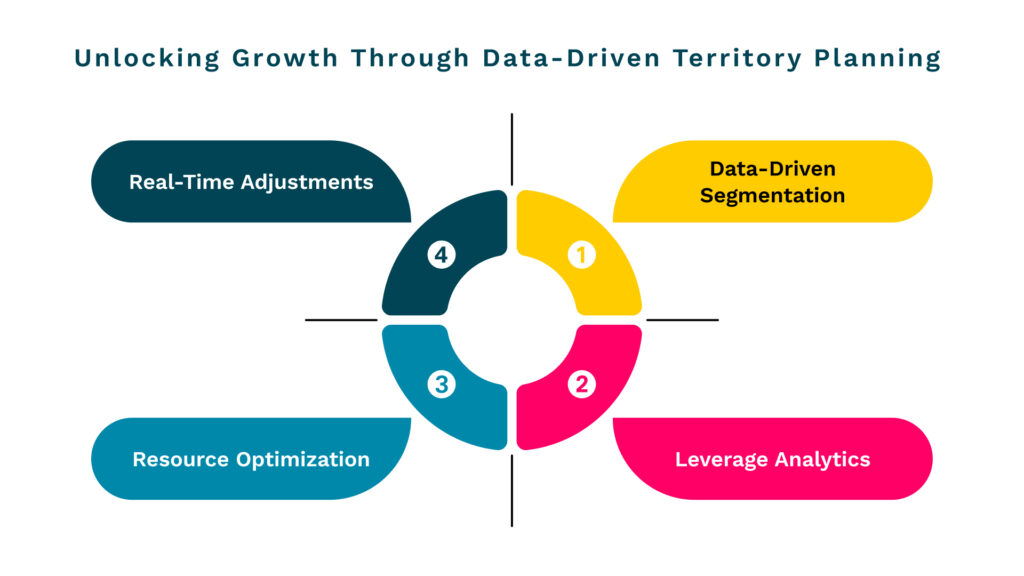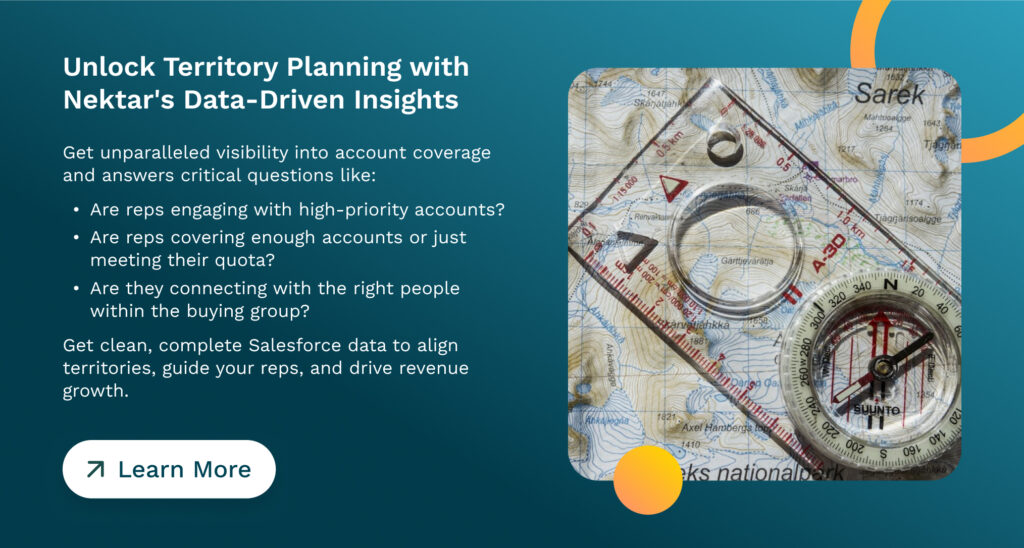
Prevent Growth Stagnation in FY25: Using Activity Data for Smarter Territory Planning
Learn how integrating activity capture into territory planning can help prevent growth stagnation & make smarter, data-driven decisions.
As businesses grow and markets shift, accurately assigning sales territories is critical for maximizing revenue and growth potential. Yet, many revenue professionals struggle with this. A Gartner report found that 92% of sales leaders believe territory planning directly impacts sales performance, but nearly half admit their teams lack the data needed to do it effectively.
The core of this problem lies in insufficient visibility into sales activities, leading to unbalanced workloads, missed opportunities, and wasted resources. When sales reps aren’t targeting the right accounts or aren’t engaging with key decision-makers, competitors swoop in, and growth stagnates.
This is where activity capture comes into play. By harnessing data on sales reps’ interactions—meetings, emails, engagement with accounts—teams can get a real-time view of their performance, spot gaps, and optimize resource allocation. In fact, companies that use activity data in their territory planning process have seen 15% higher sales quota attainment, according to Salesforce’s 2024 State of Sales report.
In this blog, we explore how integrating activity capture into territory planning can help sales and RevOps teams prevent growth stagnation and make smarter, data-driven decisions. Let’s first look at some of the challenges that organizations face with poor territory planning.
Challenges of Poor Territory Planning
Without proper planning, companies face significant risks:
1. Slowed Growth: Missing Opportunities in High-Potential Accounts
Inadequate and poor territory planning especially in cases where activity data is not utilized poses a dangerously high stagnation. While sales reps may appear to have achieved the desired outcome number, they might be overlooking untapped opportunities in high-potential accounts.
As per the Salesforce’s 2024 “State of the Connected Customer” report, 98% of sales leaders agree that the existence of reliable data is immensely useful to organizations that seek growth through sales. The problem arises when teams fail to recognize hidden potential within their existing accounts.
2. Missed Potential
Unless you understand what the account reps are doing at the account level, it would be very difficult to determine where the accounts with the most future growth are being actively chased or if reps are simply keeping things in the same place. This usually results in relationships that are poorly built and opportunities that are missed.
With Nektar’s engagement scoring system, you gain complete visibility into all account activities, helping you track metrics such as meeting frequency, inbound emails, and the involvement of key personas. This visibility ensures that teams do not overlook any potential opportunities and allows them to focus on any areas that have been neglected.
3. Loss of Market Share: Competitors Capitalizing on Gaps in Territory Planning
In a hyper-competitive B2B Marketplace, not engaging with any account is just inviting other players within the market to fill the gap. Without full visibility into account engagement, you’re left in the dark about how well your reps are covering
Competitive Threat
The danger lies in accounts that receive little or no engagement—they become easy targets for competitors. If your team is only engaging a small portion of the buying committee, your competition may already be building relationships with the key decision-makers you’re missing.
Nektar’s multithreading and powerthreading scores allow you to see if your team is reaching multiple decision-makers within an account. This means that rather than over-relying on one contact, you utilize the system as a means of outreach to all necessary personas and close the deal while beating the competition.
4. Capacity Issues: Overloading Reps Without Optimizing Resources
Sales teams can look really busy but poor territory planning may lead to poor deployment of people and unrecaptured opportunities. Reps can take on too many accounts and not cover them adequately. This results not only in missed opportunities but also in the stress of your sales force. This not only results in lost opportunities but also burnout among your sales teams.
Challenge of Resource Allocation
Without accurate data, you may not know if your reps have the bandwidth to handle their assigned territories. This can lead to poor coverage, with some high-potential accounts slipping through the cracks as sales reps struggle to balance workloads.
Nektar’s granular tracking of time spent per account, meeting frequency, and overall engagement ratios enables leaders to make data-driven decisions about resource allocation. Whether it’s reassessing the number of accounts assigned to a rep or reallocating territory, Nektar helps optimize coverage by revealing the true workload distribution.

Key Features of Modern Territory Planning Strategy
Modern territory planning isn’t just about dividing geographical areas. It’s about optimizing growth by identifying where your solutions are most effective, ensuring sales teams target the right accounts, and continuously adjusting based on performance data.
Organizations now rely on data-driven territory planning, using technology and analytics to segment accounts based on value and engagement potential rather than simple geographic or demographic factors. This shift allows teams to prioritize outreach efforts with precision and focus on high-value opportunities.
With advanced analytics, businesses can better identify high-potential accounts. By understanding customer behavior and market trends, you can target accounts with the greatest potential for success, fine-tuning strategies to meet specific audience needs.
Let’s dive deeper into some of the most essential aspects of effective territory planning:
1. Market Analysis
Market analysis is fundamental to modern territory planning. It identifies geographical areas, industries, or sectors where your solutions can create the most impact. This helps sales teams focus on regions or verticals most likely to grow, driving targeted efforts where they matter most.
a. Growth Concentration
By focusing resources on high-growth areas, companies maximize the return on their sales efforts. Effective market analysis ensures no opportunities are missed, and resources are concentrated where they can have the biggest impact.
b. Strategic Insights
Strategic analysis helps identify which regions or industries offer the highest returns, directing resources where they’re most effective. This is enhanced by using analytics tools that synthesize data from various sources, such as economic indicators and competitive assessments, giving a complete view of where your sales efforts should be focused.
2. Resource Allocation
Efficient resource allocation is key to effective territory planning. Assigning territories based on workload, opportunity, and activity ensures there are no overlaps or gaps in coverage. With modern tools, sales teams can make real-time adjustments to territory assignments as market dynamics shift.
a. Data-Driven Distribution
By analyzing performance and potential, territories can be distributed more evenly among reps, balancing workloads to ensure maximum productivity and minimizing resource strain.
b. Real-Time Adjustments
As market conditions change, so must your territory strategy. Modern tools allow for quick adjustments, reallocating resources to areas of opportunity or addressing market demands, keeping your sales teams agile and proactive.
3. Customer Segmentation
The planning of sales territories includes the consideration of the risks and growth potential of customers. By redrawing the borders to serve both high value and high-risk accounts can earn maximum outputs.
A multithreading score can shed light on whether key personas within various segments are being engaged by the teams. This manner of segmentation ensures that rather than solely going after lucrative opportunities, reps are also capturing potentially revenue opportunities from risky customers balancing churn management with growth maximization.

Nektar: Granular Visibility for Optimized Territory Planning
Nektar provides RevOps teams with unparalleled visibility into account activities, enabling effective territory planning and resource allocation. Here’s how Nektar helps tackle common territory planning challenges:
Being disorganized in assigning territories can cost a company revenue and hamper the growth because of missed opportunities. These challenges are addressed by Nektar through a granular visibility of all engagement activities. Thus, furnishing RevOps with necessary tools for territory planning and decision making.
Nektar’s solution employs best practices so that RevOps teams have a clear view of all the accounts and their activities for optimal territory planning which brings about measurable business outcomes. Here’s how Nektar specifically addresses each of the common problems:
1. Comprehensive Engagement Tracking
Nektar tracks all the interactions between sales reps and their accounts, from meetings and emails to any other touchpoints. By collecting this granular data, RevOps teams can clearly see which accounts are being actively engaged and which ones are not. This helps:
Mapping Accounts
Identify high-priority accounts that may be overlooked.
Reassigning Territories
Reassign under-engaged accounts to reps who can dedicate the necessary time to them.
Balancing Territories
Balance workloads effectively by redistributing accounts based on activity levels.
2. Engagement Scoring for Better Decision-Making
Nektar employs an engagement scoring mechanism that evaluates account activity metrics like the number of meetings held, inbound versus outbound email ratio, interaction with the decision making personnel, etc.
Account Activity Ratio
This score provides a clear indicator of the account activity ratios so that the leadership makes optimal choices regarding territory assignments, level and in general the account strategy.
For instance, if a rep is assigned 80 accounts but only engages with 30, Nektar’s engagement scoring can highlight these discrepancies. RevOps teams can then scatter the rest of the accounts among themselves or recruit more reps to cover the workload, thus ensuring that the revenue is not lost as a result of missed opportunities.
3. Unified Data Across Teams
Nektar integrates seamlessly with both sales and customer success platforms to present a single view of activity with an account. This cross-functional alignment ensures that:
Cross Team Alignment
Sales and Customer Success are up-to date with the latest information and are working towards a shared goals
Stakeholder Mapping
Key stakeholders are accurately mapped within each account, reducing the risk of sales teams targeting the wrong personas.
Post Sale Activities
Post-sale activities, such as onboarding or renewal efforts, are also informed by accurate engagement data, leading to a smoother customer experience.
4. Granular Visibility for Territory Planning
With Nektar’s ability to track activities and engagement levels across accounts, RevOps teams can gain detailed insights that are critical for territory planning. These insights include:
Capacity Planning
Based on the number of accounts that are currently active and those that are untapped, teams can monitor workloads accordingly. This can avoid capacity bottlenecks and ensure balanced workloads
Account Prioritization
Nektar’s activity data helps teams focus on high value accounts. This ensures that the most potential win opportunities are well accounted for.
Pipeline Optimization
Teams can also leverage engagement scoring to ascertain which prospects have high chances of converting for more accurate pipeline forecasts.
5. Actionable Insights for Revenue Growth
Nektar does not only measure activities; it helps in providing activities that can affect revenue positively. For instance:
Corrective Action
Nektar’s platform can identify accounts that haven’t been touched in weeks. RevOps teams can initiate corrective action by redistributing logs or changing sales behaviors to spark interaction.
Bridging Resource Gap
With a clear understanding of how much time is spent on each account, teams can identify resource gaps and justify additional hires or shifts in strategy to accelerate growth.
6. Enriched CRM Data
Nektar’s engagement data is integrated directly into Salesforce. This provides real-time access to all the teams leveraging these insights. Nektar enriches Salesforce with key metrics such as the number of activities logged, personas engaged, and time spent on accounts. These aspects are vital for leaders for effective planning and management of sales.
Why Choose Nektar for Territory Planning?
Nektar’s solution is designed to optimize territory planning by providing RevOps teams with detailed visibility into account engagement, capacity, and resource allocation. Its engagement scoring and capacity planning features ensure no account is neglected, allowing organizations to capture every potential opportunity.
With Nektar, you gain the tools to not only streamline processes but also grow revenue and market share by making data-driven decisions about where to focus your resources.
Ready to transform your territory planning?
PUBLISHED BY







